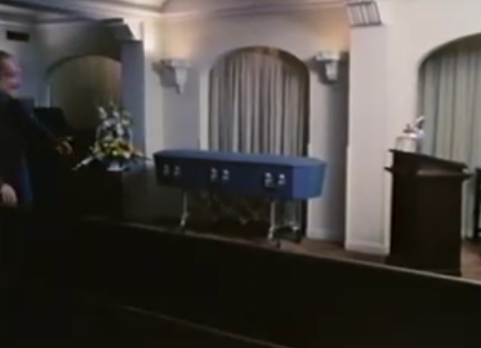
Image credit: screen shot of Harlan County, USA
Over the past few weeks my students have been discussing
several documentary films and a recurrent topic has been the line between an emotional appeal and an
exploitative image of the body in pain.
We have considered key scenes in the documentary Harlan County, USA (1976) in which director Barbara Kopple closely
trains her camera on a man struggling to breathe through the pain of black
lung. We will also discuss the
inclusion of several open-casket shots of a child’s dead body in Martin Bell’s Streetwise (1984).
The ethics of documentarians is a topic I’ve considered before on this
site, but this week my student’s surprised me by probing the distinction
between images of an actual body in pain and simulated images of a body in
pain.
Now I wish I had anticipated this turn in the discussion—had
I been prepared I might have thought to bring in clips from several documentary
filmmakers and images from several photographers. Re-enactment scenes from historical documentaries, images of
torture of popular films such as Saw and
violent clips from video games like Grand Theft Auto, along with Cindy Sherman’s film stills series might have helped us consider the many ways image-makers have troubled the line
between representation and reality.

Image credit: Cindy Sherman, Untitled Film Still #14
In his article, “Wound Culture: Trauma in the Pathological
Public Sphere,” Mark Seltzer contends with the condition of postmodernity and
although he does not explicitly address photography I think some of his work
might have been applicable to our discussion. Seltzer posits a postmodern “wound culture” in which there
has been a breakdown in distinctions between external/internal, public/private,
self/other. This breakdown occurs
because the “virtual and figurative look just like and hurt just as much as,
the literal and the real: perception and representation change places”
(Seltzer, 24). For Seltzer is the site of the wound that collapses the boundary
between real and representation by splaying the private body before public
eyes. At the same time, the wound
fascinates us because, despite the trauma of this collapse, it seems to
maintain such a clear distinction between what is real and what is not. What can be more real than the
wound? It is hard to argue with
blood and guts.
Selzter’s analysis of the would as the site of all this
blurring of boundaries can be extended to the photograph: a private moment
captured and circulated for the public eye, an image that is both of reality
and a representation of reality. Several of the distinctions Seltzer notes
—between external/internal, public/private, self/other—are broken down within
photographs. The shots of miners
struggling to breath and the open-casket images prompt questions about the use
of violent images or images of violence.
Is there really a difference between images of an actual body in pain
and simulated images of a body in pain?
Is there any connection between violent images and violence in the
world? Is the act of taking a photograph
always violent? Seltzer seems to
suggest that in a “wound culture” it is impossible to imagine any experience
not marked by violence. It seems
worth asking whether we can imagine a photographic experience that is not
violent?
Recent comments
2 years 29 weeks ago
2 years 44 weeks ago
2 years 44 weeks ago
2 years 50 weeks ago
3 years 4 weeks ago
3 years 4 weeks ago
3 years 4 weeks ago
3 years 6 weeks ago
3 years 6 weeks ago
3 years 6 weeks ago